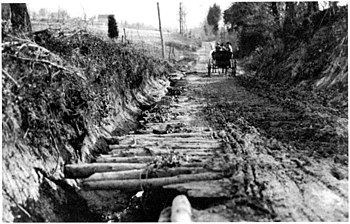
An earth road near Stafford, Va. that was repaired with pine poles about 1912.
The Complexities of Federal-State-County Cooperation
In order to treat all States equally, and also to get information representative of all parts of the country, the two Departments divided the $500,000 appropriation equally among the 48 States. They then, in a joint letter, notified each governor of the apportionment and asked that he designate about 50 miles of road within his State on which rural delivery was or might be established as an experimental post road. Five governors did not even bother to reply to this request; six refused to participate; and 28 indicated that they were unable to comply for lack of legal powers or because of conflicting State statutes. Two States, Georgia and South Carolina, declined to participate because of Federal statutes requiring an 8-hour work day and the Executive Order of May 18, 1905, barring the employment of convict labor on Government work. In the end, only Alabama, Iowa, and Oregon agreed to designate post roads and accept the Federal subsidy.[1]
By this time, nearly 7 months had passed and no projects were underway, so the two Departments tried a different approach. They decided to select from two to eight locations representative of conditions in various sections of the country and to concentrate the available funds on a few roads in these localities. This plan produced the desired result, and eventually agreements were made for 17 post road projects totaling 457 miles, located in 13 States and 28 counties, but not without practical and legal difficulties. One county in Virginia figured that it could build roads more economically by doing its own work with convicts or by free labor working 10 or 11 hours per day than by accepting the Federal subsidy, and the county canceled its agreement. The original idea of appointing a trustee in each county to hold the funds for each post road, subject to disbursement by a Federal engineer, had to be dropped in some States because of conflict with State laws. The most serious objections came from Minnesota which protested the 8-hour clause in the agreements and appealed the matter to the Attorney General of the United States, who ruled that the work contemplated under the post road program was, after all, not public work of the United States, within the meaning of the statutes, and, therefore, neither the 8-hour law or the prohibition on use of convict labor would apply.[2]
The Secretary of Agriculture turned the supervision of the post road program over to the Office of Public Roads, and Page in turn assigned responsibility to E. W. James, who detailed an engineer to each project to lay out the road, supervise construction, and approve expenditures. Cooperation with the counties was not easy. Unlike Bennington County, Vermont, which had petitioned the OPR to assign an engineer, the cooperating post road counties had surrendered their control over the joint road funds unwillingly and only to get the Federal subsidy. The Secretary and the Postmaster General described some of the difficulties in these words:
From correspondence and from the attitude of the local officials in many places it appears that there is a disposition frequently to avoid the obvious requirements of the present act with respect to Government control over the expenditure of joint funds. The allotments have been looked upon not infrequently in the light of a gratuity, the idea of the post road has been lost sight of, and the question has been frequently raised in the field as to why the Government would not give the money to the counties and let them spend it. . . .
Fiscal procedure in the States and counties, if possible, should be provided for in local statutes, written with Federal aid in mind. The longest delays, the most unsatisfactory conferences, and the most troublesome routine in the execution of the present projects have arisen because the Federal aid and supervision of local funds was not thought of when the fiscal regulations of the States and counties were made.
We find that many States incorporate into their State road laws certain details of design and methods of construction which, in any general distribution of national aid, would at once act as checks on supervision by the National Government. . . .[3]
82
